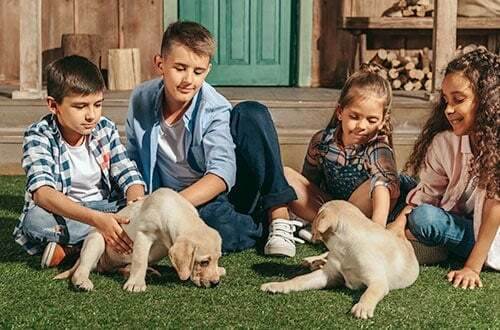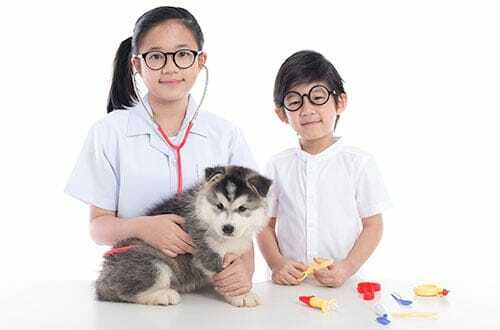A Breeders Guide to Early Socialization
Providing The Best Breeding Services
Gabrielle Plascak CPDT-KA
Science teaches us that the behaviors and stability of a dog stem from both nature (genetics) and nurturing. Although good genetics play a huge role in the quality of dog, the way a puppy views his world from the moment he is born is equally as impacting. So that leaves us with the big question, why are so many breeders leaving it up to owners to implement socialization 8-12 weeks after it should have started?
Here are some ways to implement socialization in your breeding program that will carry a lifetime of benefits for your dogs and your customers.

The first few weeks
When puppies are born they continue developing eurologically. This can be a great opportunity to get your pups familiar with touch and handling. There is no need to sit with them all day smothering them! Just brief positive touching and handling at the early age while increasing in length and amounts as they grow.
Friends or foes

8 weeks and not a day before!
Although they will have begun the weaning process at about 4 weeks, having the ability to stay with the mother dog and engage in brief nursing sessions until 6-8 weeks is important socially. Unless there is a medical reason, try to keep your pups with the mom! On that same note, do yourself and every previous, potential and future dog owner a favor and never let your puppy go to a home before 8 weeks of age. Even better, don’t let them go to homes until 10-12 weeks. At this age, puppies are going through a fear period. Anything and everything has the potential of becoming a negative experience causing permanent damage to the dog psychologically and behaviorally. Staying with litter mates and the mom those couple weeks extra not only provides the social learning experiences they need with other puppies, but it will help protect them from becoming severely fearful, or possibly aggressive later on in life.
Here are some ideas on ways to provide positive interactions during those crucial weeks of fear.
People are friends, not food

What's that sound?
Noises! Play music, audiobooks with different voices and begin exposing them to everyday noises that they will experience in life. Things like a vacuum, honking horns, and blow dryers. This list can go on endlessly but if you think about the types of homes your puppies will go to and begin to expose them positively in controlled environments you will be on the right track.

A walk in the park

Think outside of the box
When the term socialization is thrown into a conversation the majority of people assume that it means being “social” with people and other creatures. They think that it means to play or to build relationships. While this is part of the definition and it IS vital to their development, there is more to socialization than your casual play date. The definition of socialization is “the process of learning to behave in a way that is acceptable to society”. With that being said, take into consideration what dogs in our society are expected to do on a day to day basis and begin providing them positive interactions to those things at early ages.
Some ideas are crates, cars, leashes, collars, and other equipment. From walking across different surfaces (gravel, grass, sand, concrete, snow, water, across boards and over grill racks) to playing with different types of objects or eating out of different devices.

Prep for the vet
There are things you can do to start preparing them for many future vet visits. Treat and feed out of syringes, take time to handle their ears, paws, and other various body parts. Place different object up to their feet, legs, and neck to prepare for vaccines, medication, and grooming. Always follow with a treat or something reinforcing. Exposing them to different surfaces and objects, like mentioned above, can help them prepare for scale weighing and exams on metal tables.

Be proud and talk about it
Not many breeders take the time to implement a socialization protocol with their puppies and not only is it important for the dogs, it is a way to market your business. Maybe you are the only breeder in your area that offers a socialization protocol. Put it on your website, show pictures of your sensory areas, and show off your knowledge on the subject. People buy puppies because they have a clean slate and they want to pick the one that has the highest chance of becoming a socialized, well-balanced adult dog.

As a breeder, you are bringing dogs into this world for various reasons but every single breeder has the chance to preemptively give each dog the best shot at a happy, healthy life. Dogs are superstitious in nature. If something is unfamiliar it might be dangerous or scary. This is the case even if something hasn’t been negatively associated with a traumatic event. It is your duty, as a breeder, to influence these little puppies while they are at the perfect age to learn new things can be fun and rewarding.

